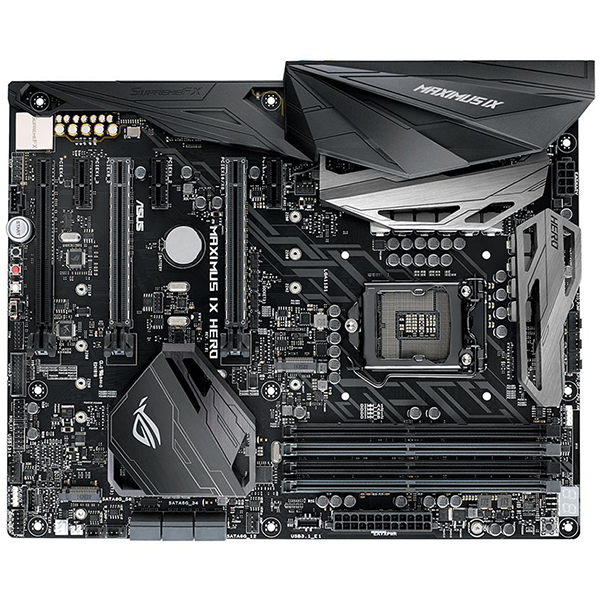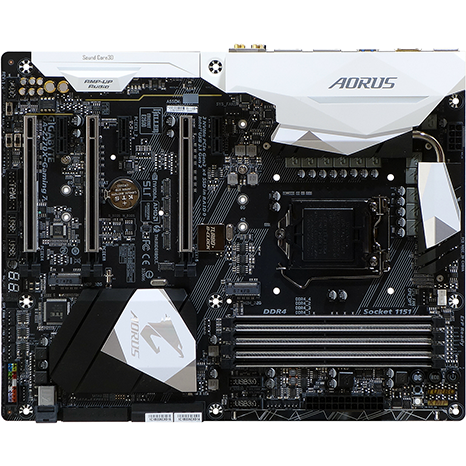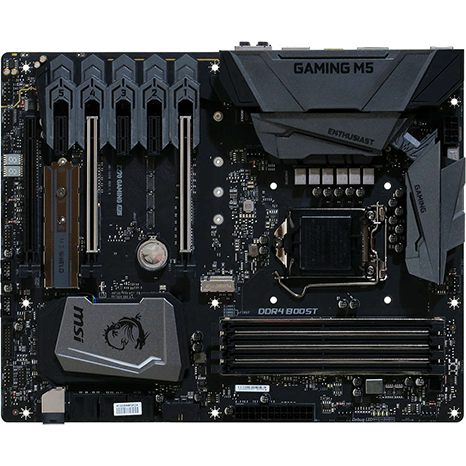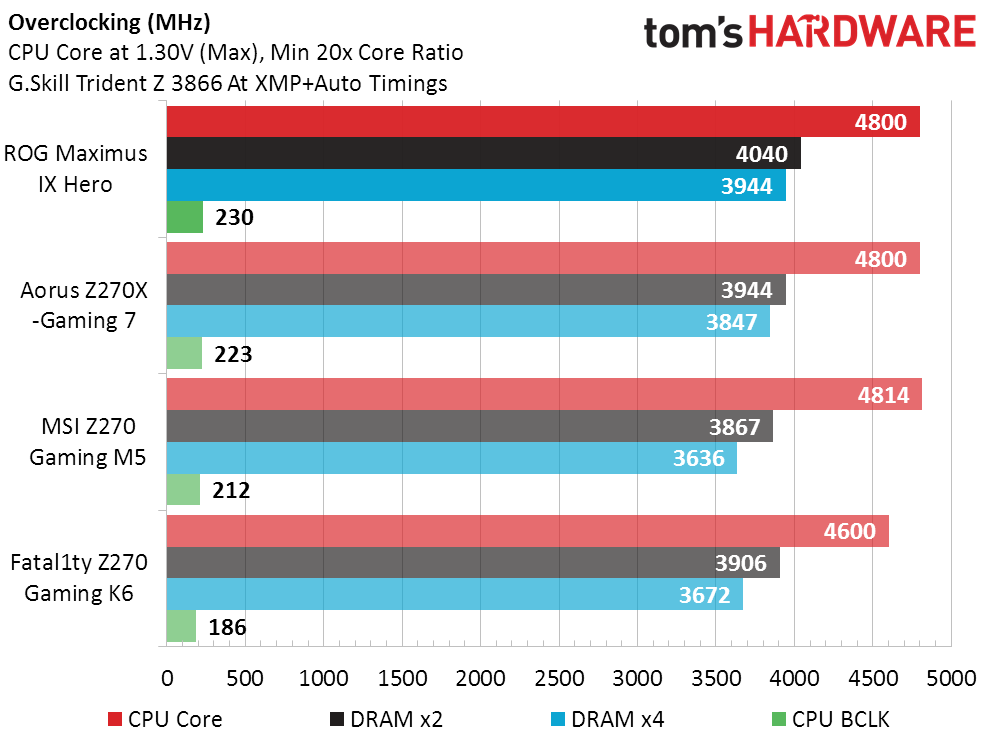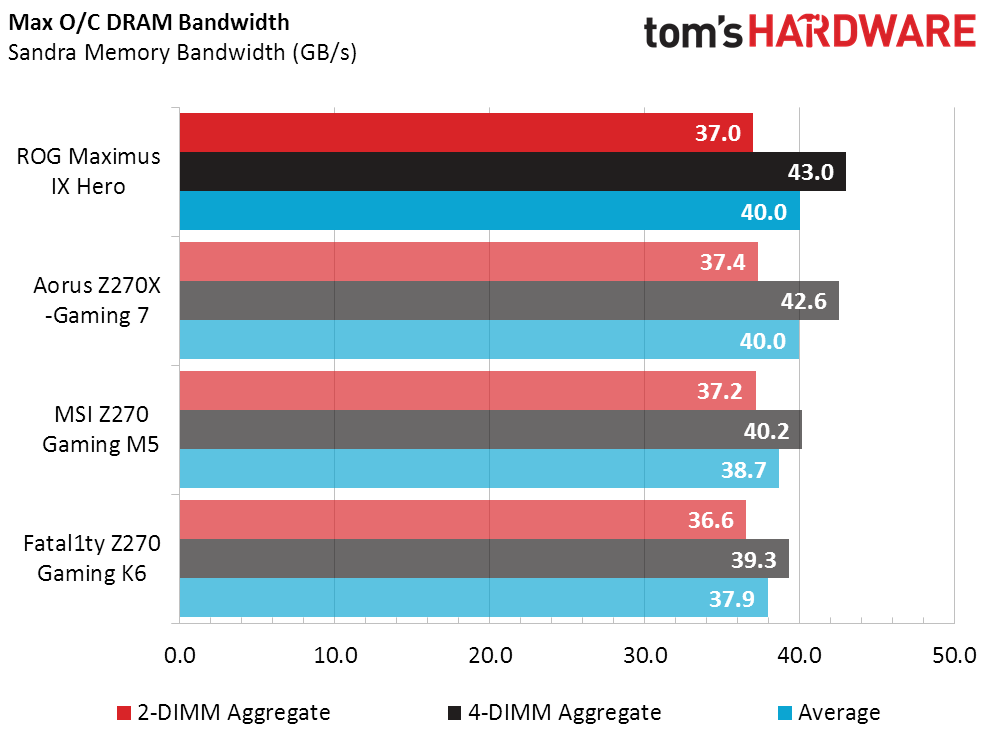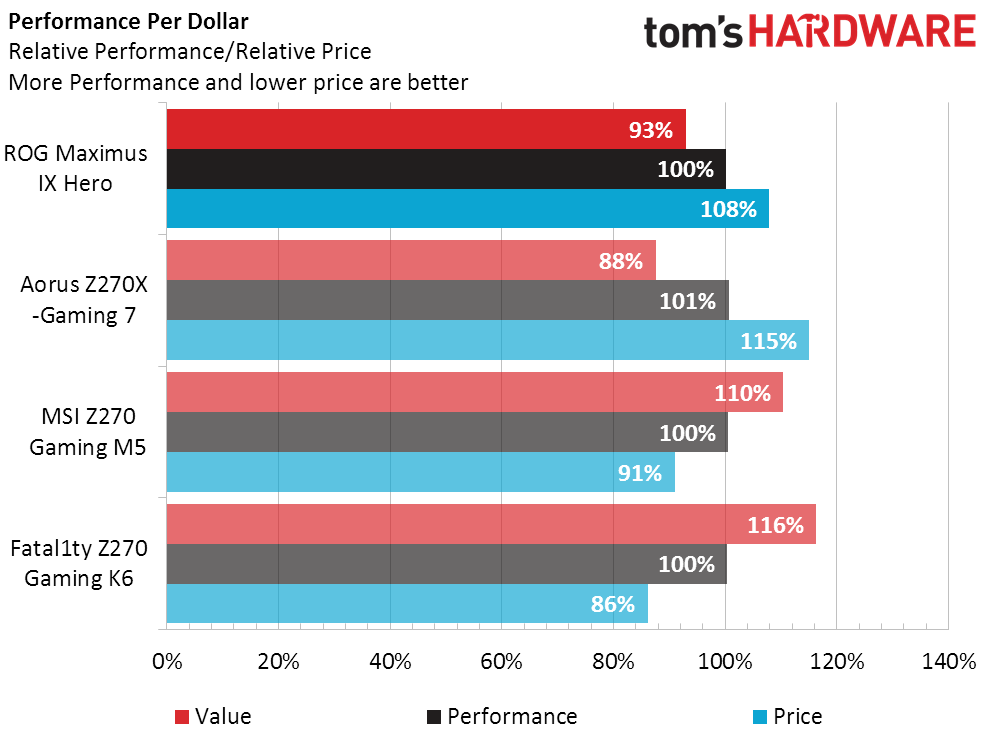Asus ROG Maximus IX Hero Intel Z270 ATX Motherboard Review
Designed for gamers who overclock and show system builders who want to look like gamers who overclock, how well does the Maximus IX Hero actually overclock?
Why you can trust Tom's Hardware
Test Configuration, Results, And Final Analysis
Asus’ ROG Maximus IX Hero takes on the Aorus Z270X-Gaming 7 for overclocking for the money, while MSI’s Z270 Gaming M5 and ASRock’s Fatal1ty Gaming K6 show what’s possible at the lower portion of the high-end market. All four boards have a similar range of available overclock settings:
Test System Configuration
| Sound | Integrated HD Audio |
|---|---|
| Network | Integrated Gigabit Networking |
| Graphics Driver | GeForce 372.90 |
Synthetic Benchmark Results
We disable any fixed-frequency Turbo Boost override functions and enable all power savings features, such as the full range of Intel C-States, prior to benchmarks. This allows CPU performance to be measured “as Intel intended,” but it also makes it difficult for motherboard manufacturers to produce any performance advancement.
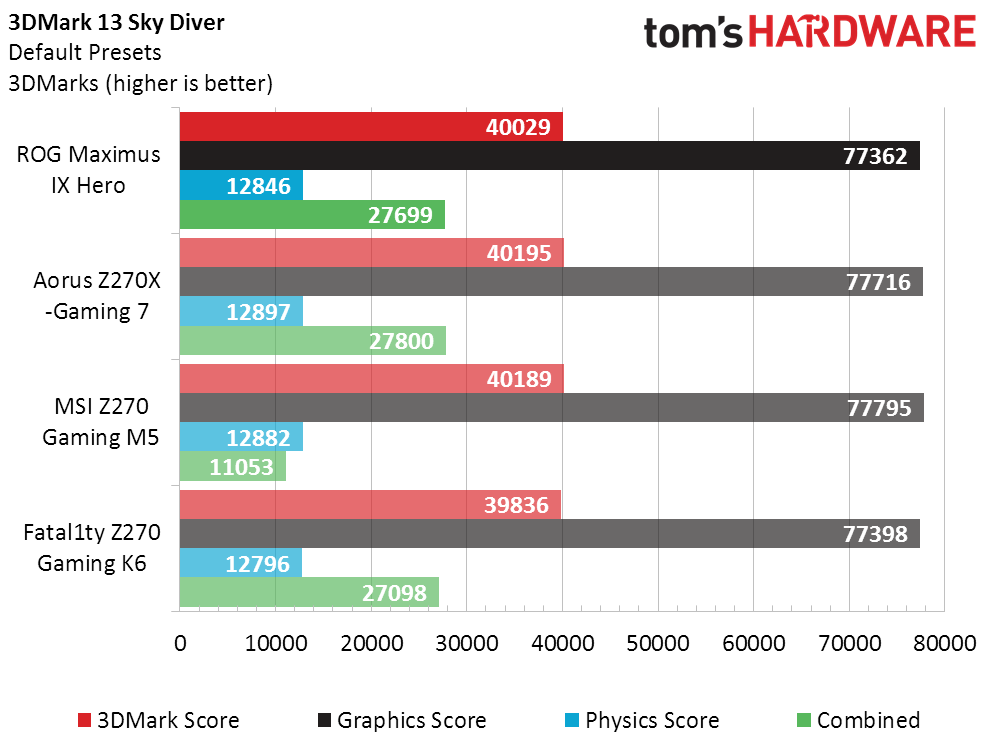
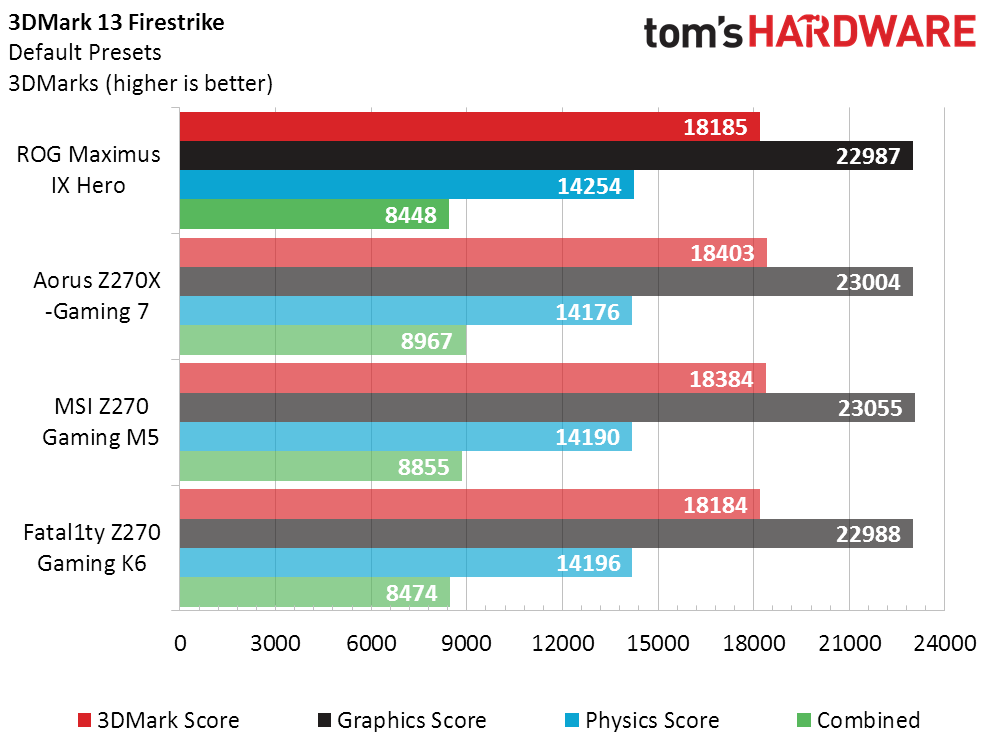
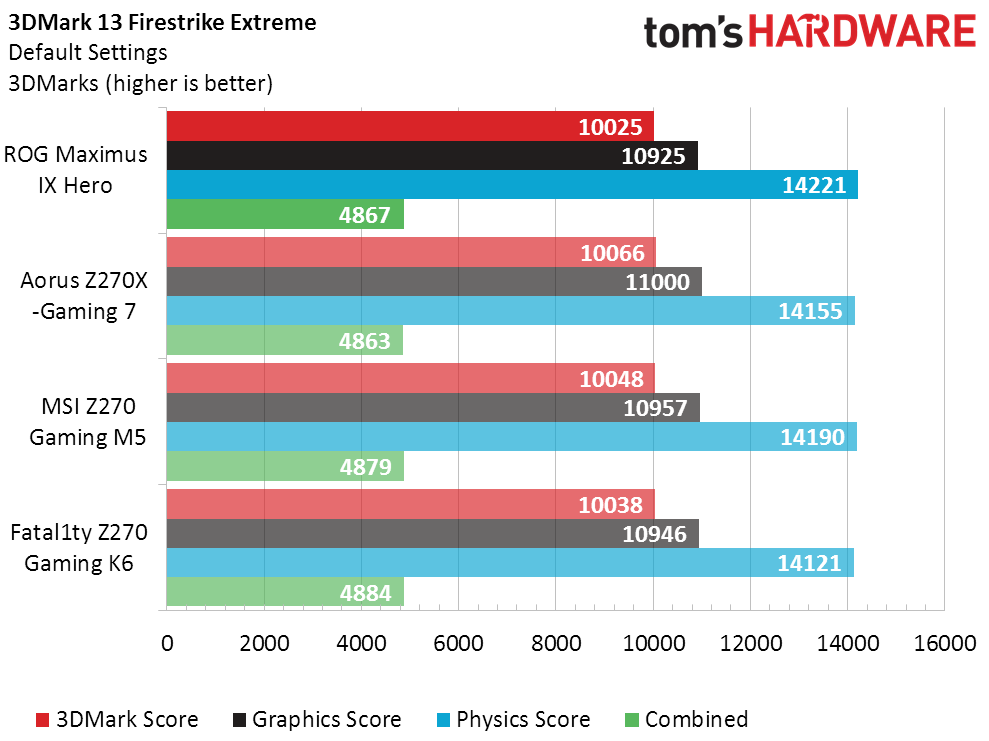
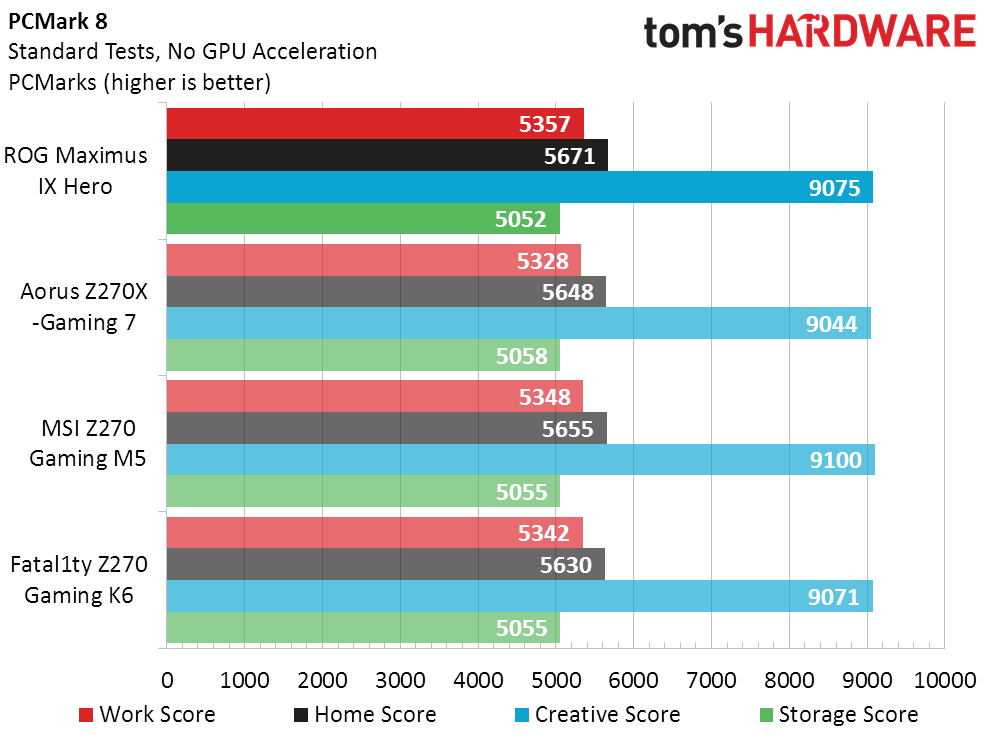
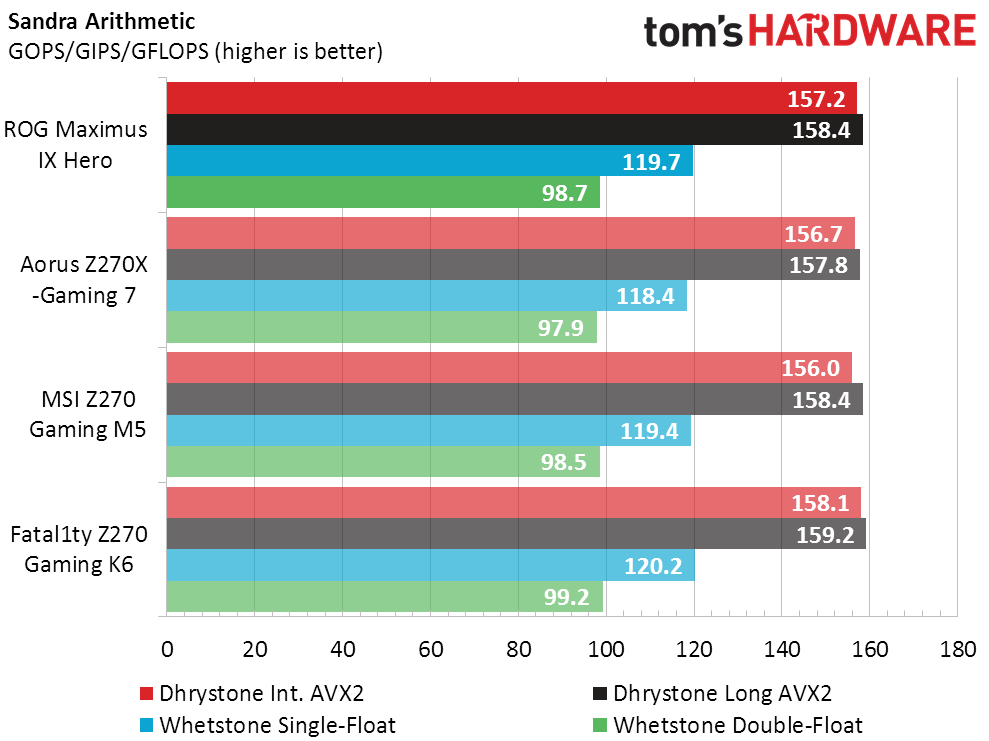
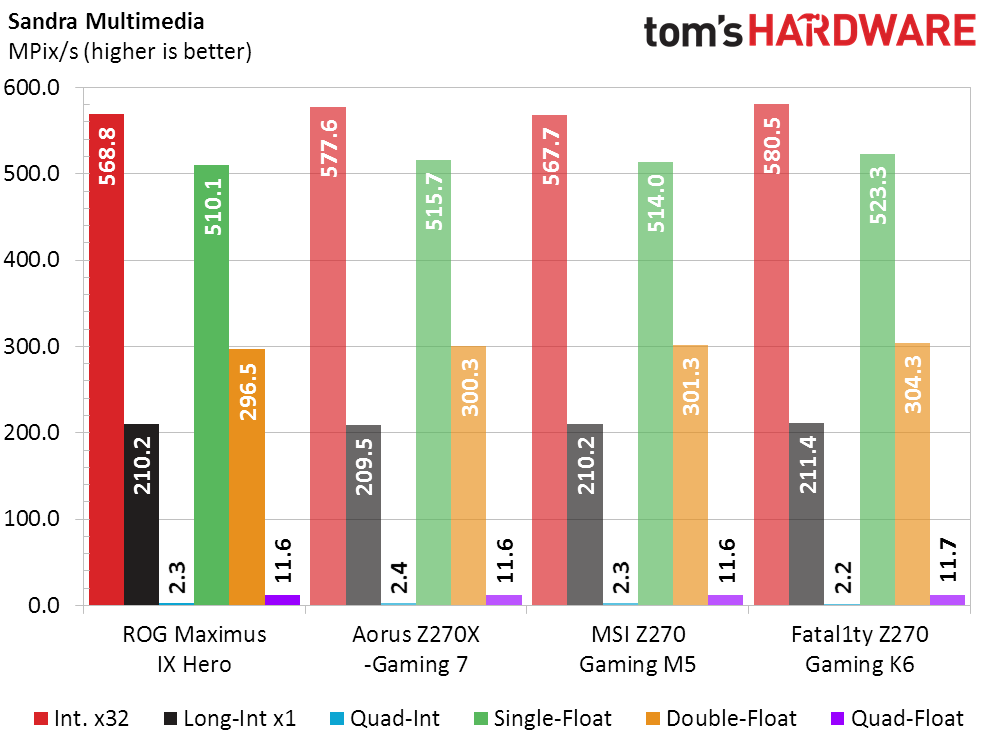
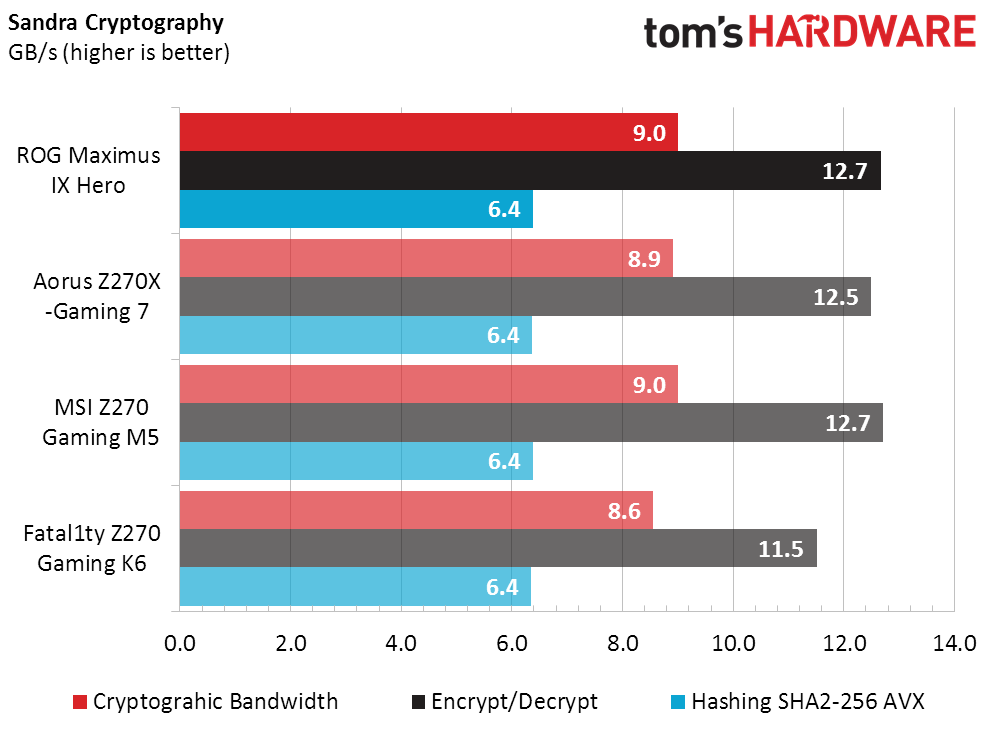
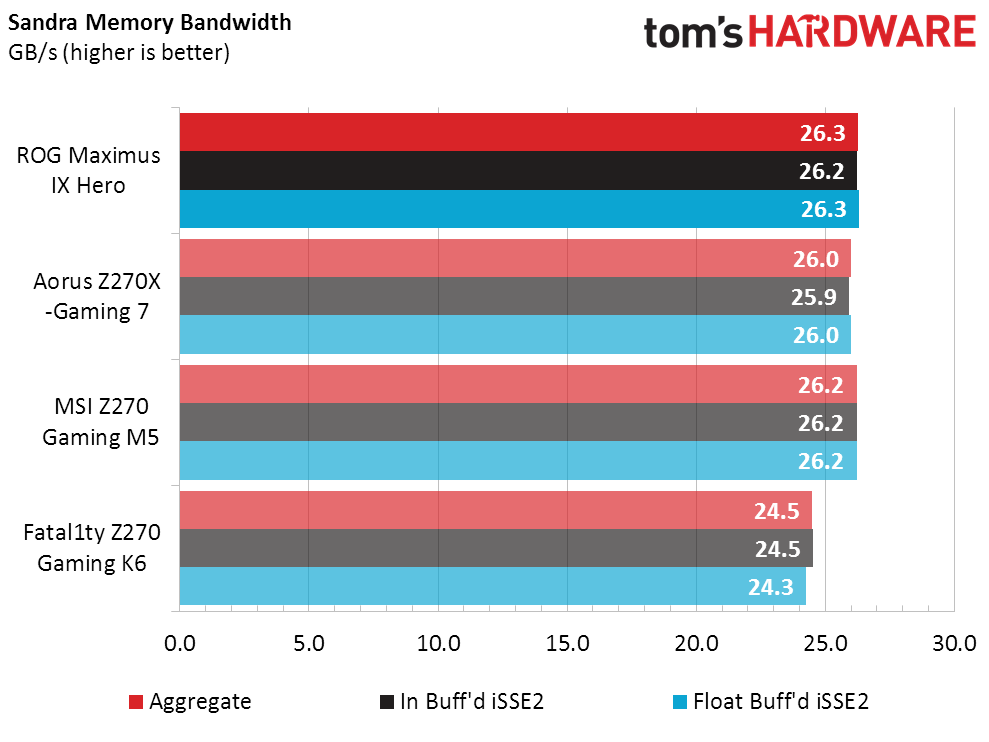
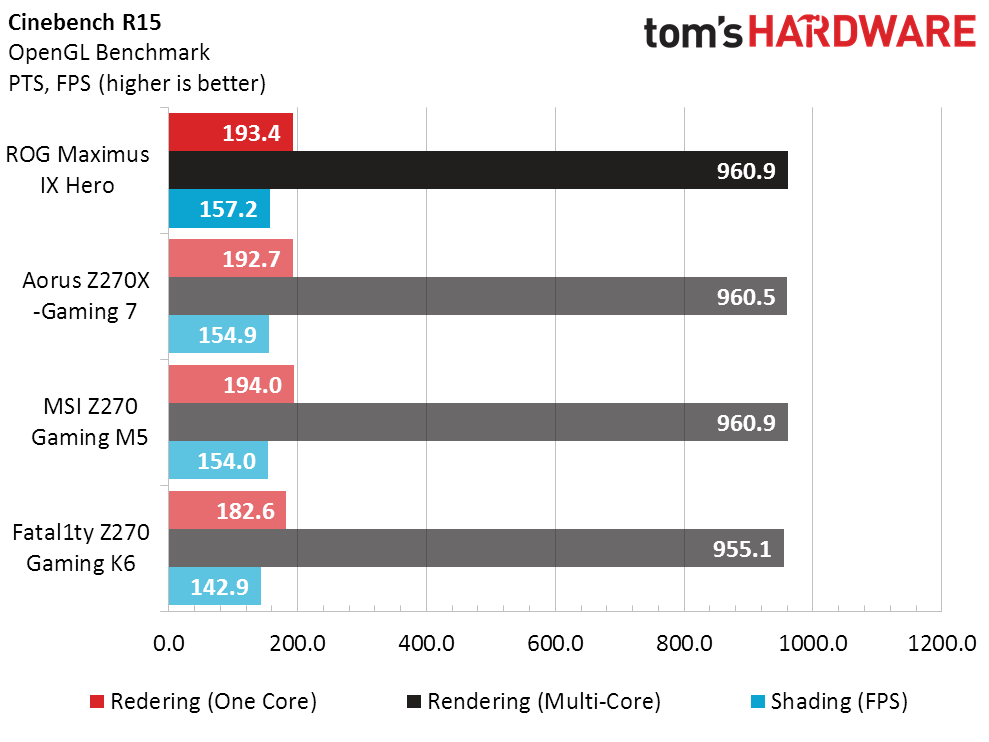
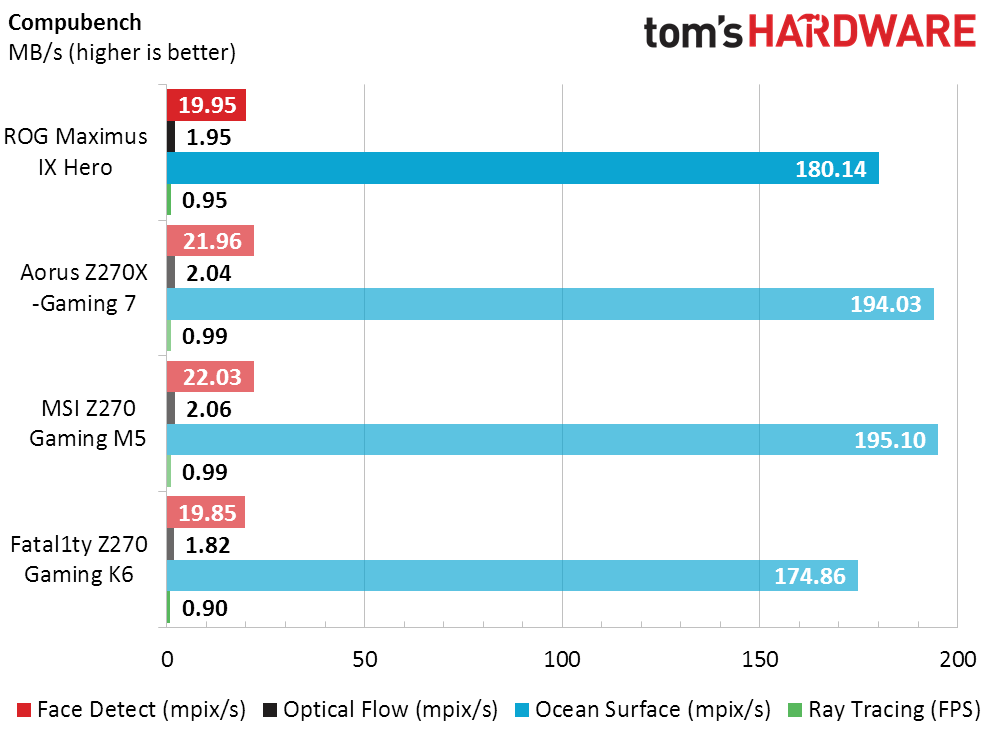
A clean benchmark set would show all boards with extremely similar CPU performance, and our Synthetic results live up to that ideal. ASRock’s sample falls slightly behind in memory bandwidth, which also drags its Gaming K6 down a little in Sandra Cryptography.
3D Games
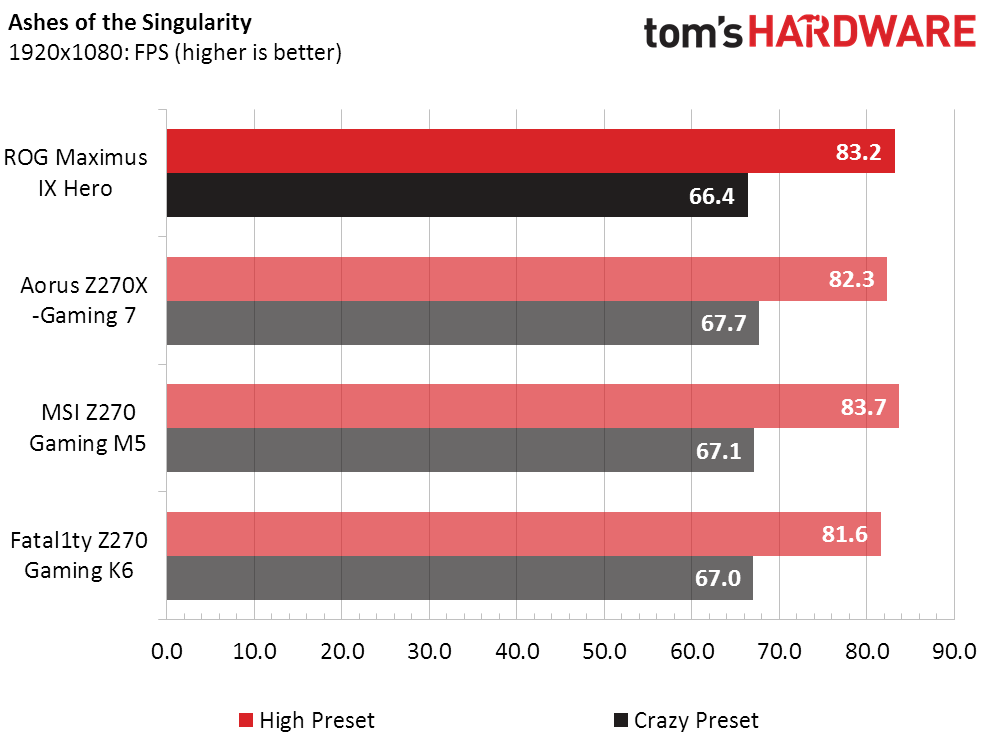
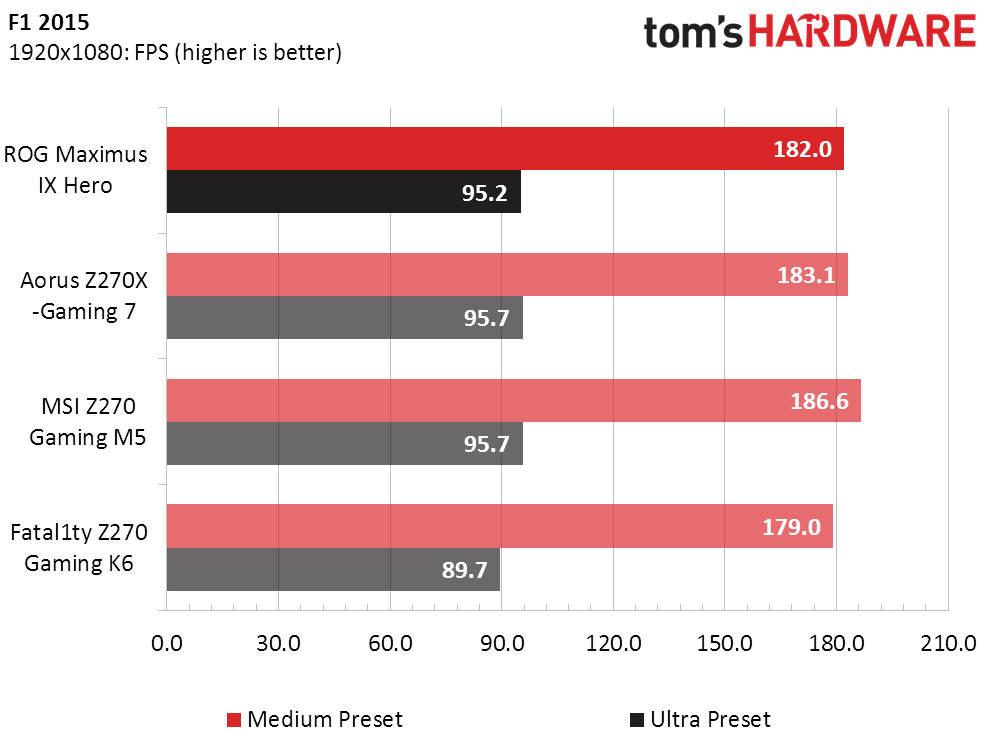
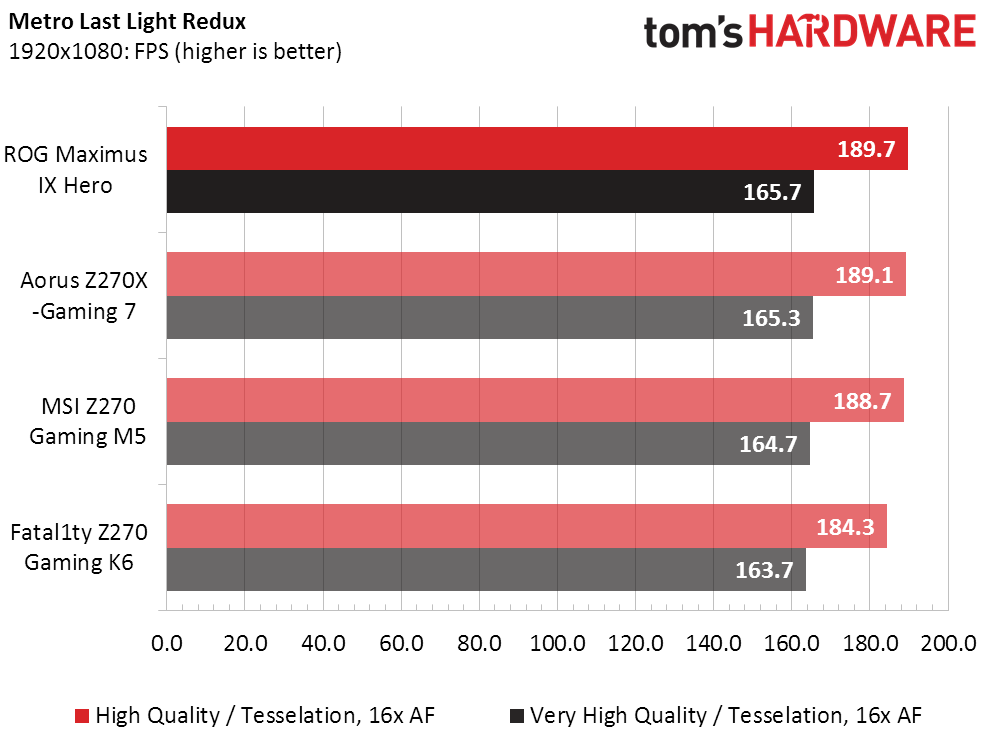
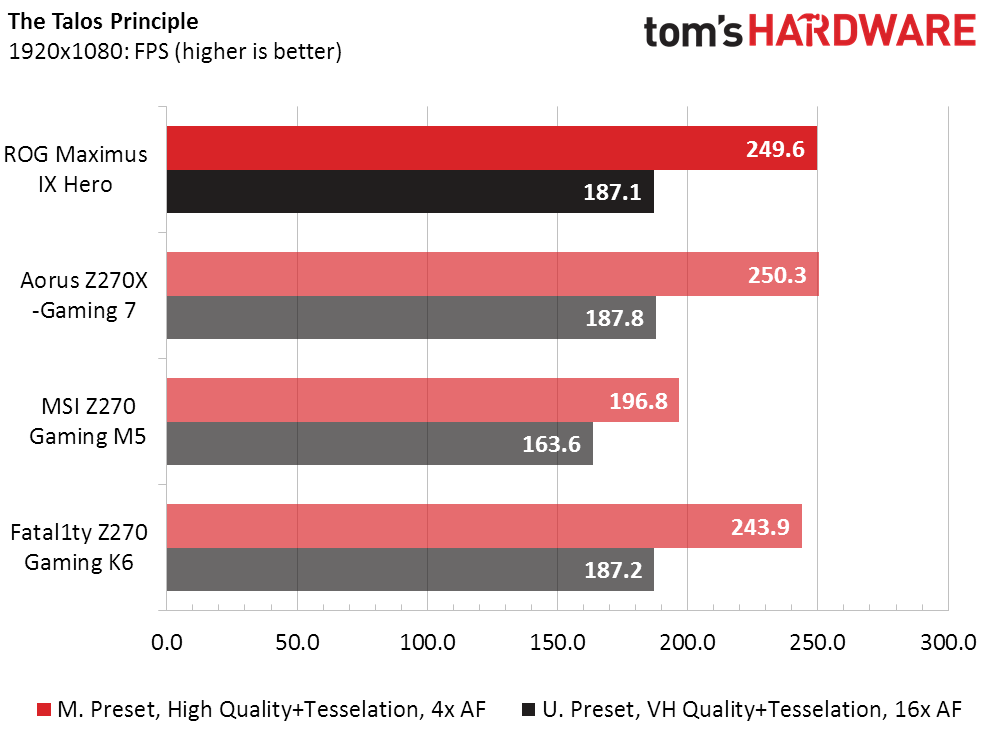
The Maximus IX Hero performs on par with the Z270X-Gaming 7 across our gaming suite, while the Z270 Gaming K6 falls only slightly behind. The Z270 Gaming M5’s mixed results occur when its Nahimic audio solution is enabled, as illustrated in this advanced chart.
Get Tom's Hardware's best news and in-depth reviews, straight to your inbox.
Timed Applications
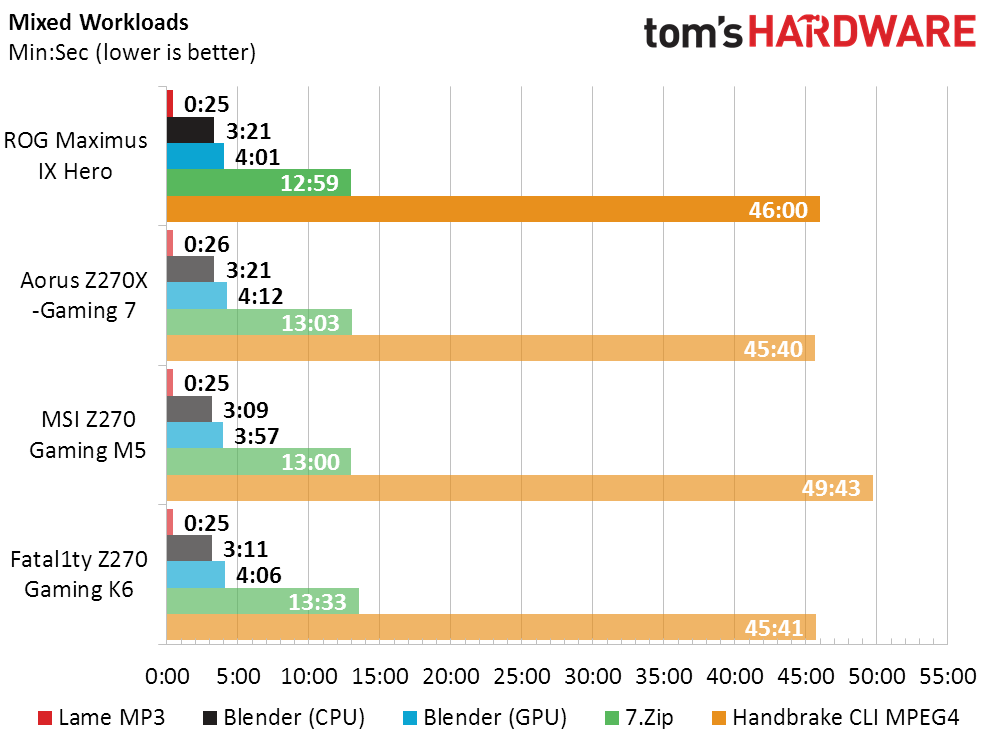
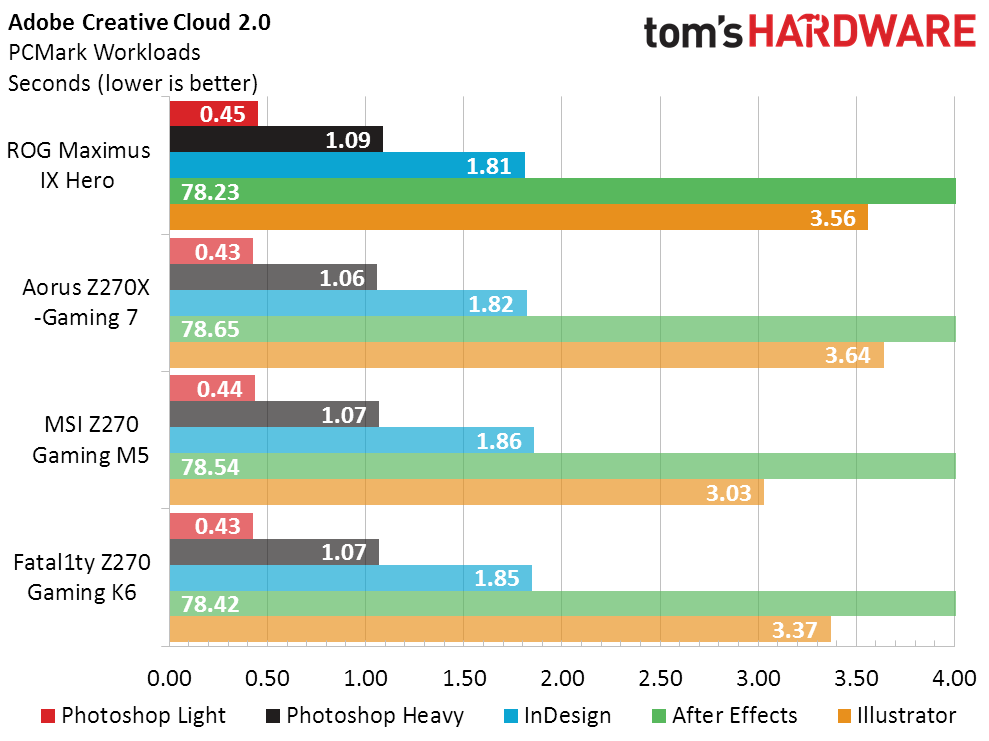
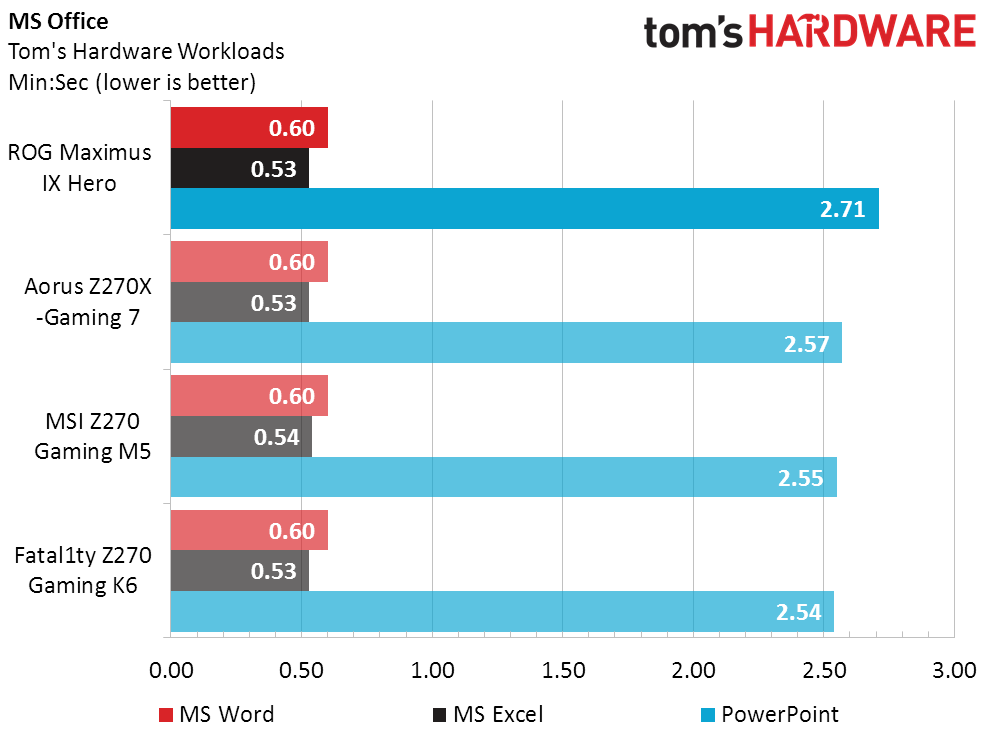
The Maximus IX Hero comes out a little better than average in mixed workloads, and a little worse than average in the MS Office test, for an average (timed test) average (all tests) that’s about average (for the group). Follow?
Power, Heat, And Efficiency
The ROG Maximus IX Hero uses less power at full load with all processor defaults enabled (like all the competing samples). It also produces less heat with these features.
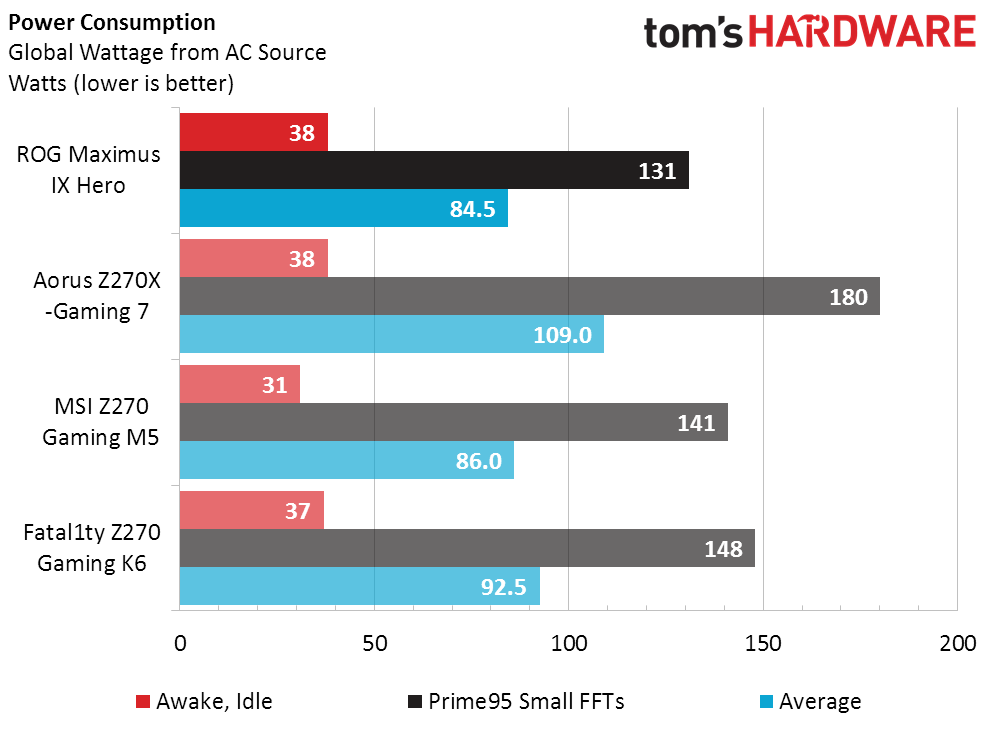
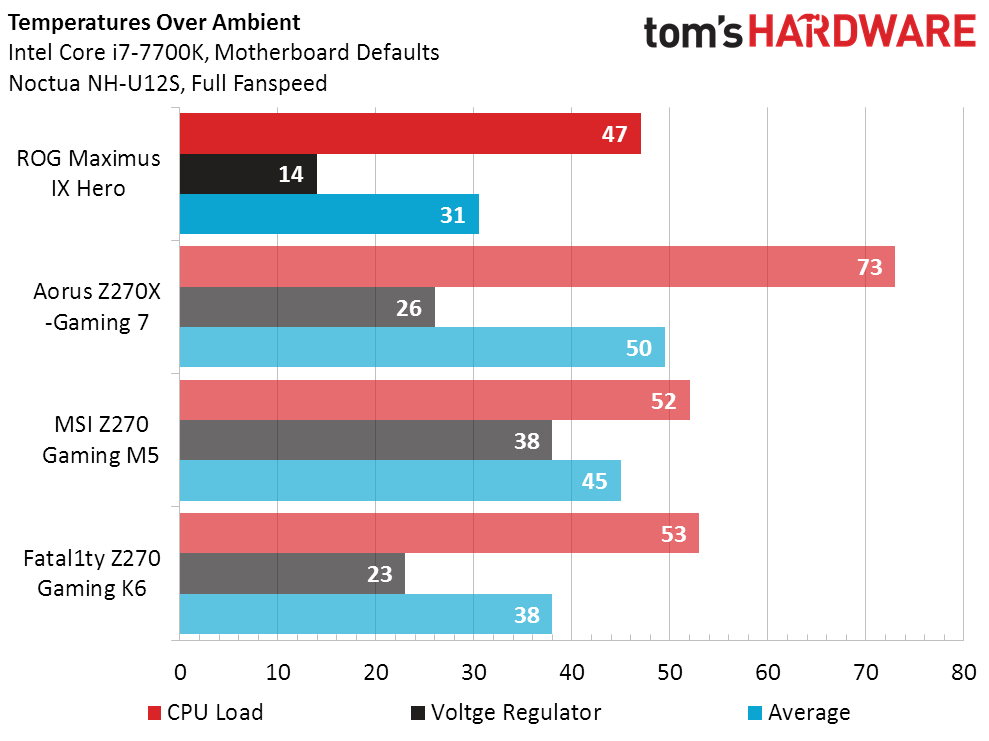
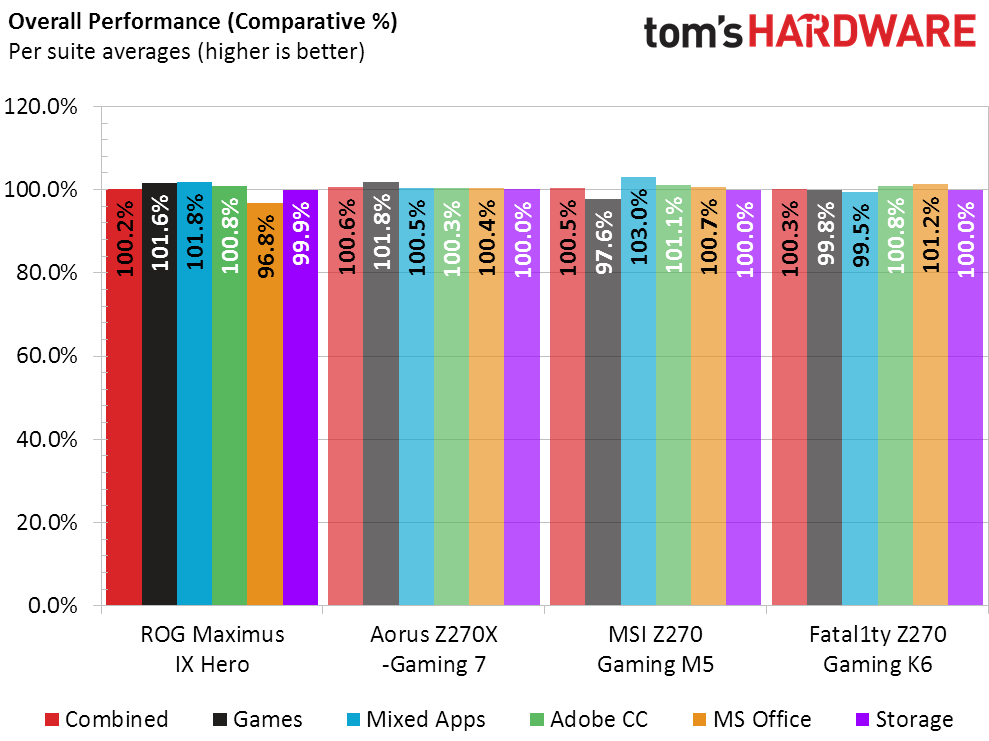
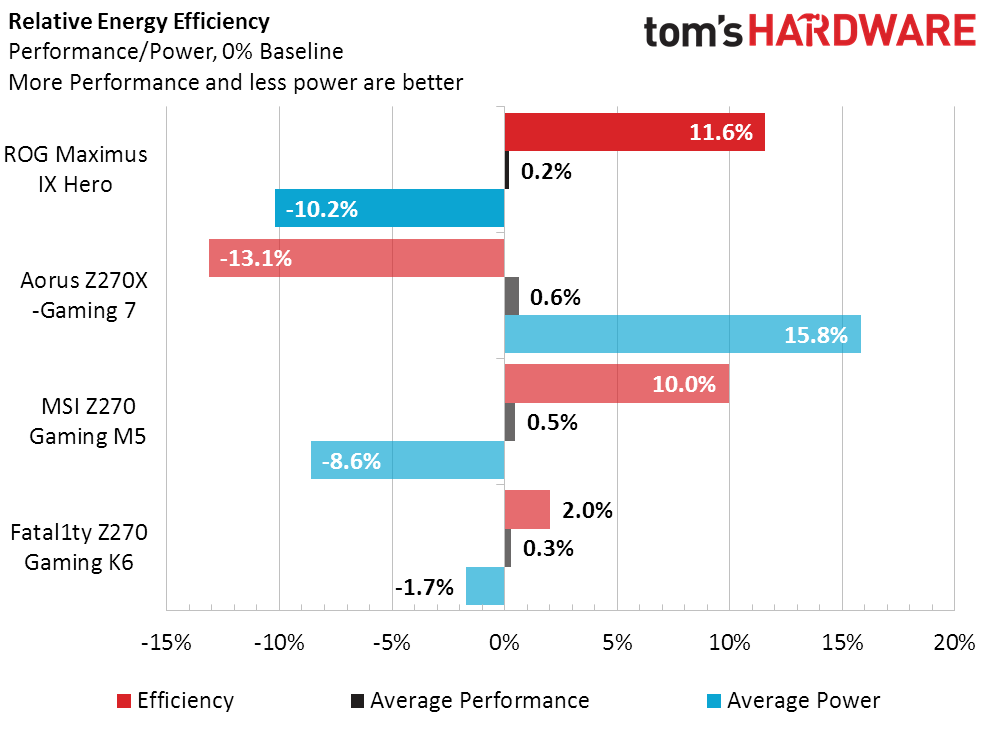
Slightly above average performance and significantly below average power consumption combine to put the Maximus IX Hero at the top of our efficiency scale.
Overclocking
We mentioned that the Maximus IX Hero produced record overclocks for our DDR4-3866 DIMMs at a measured 1.35V, and the last part of that statement is significant since each of these boards jumps to higher-than-rated DIMM voltage levels when XMP is enabled. The extra 10mV to 20mV automatically applied by any of these boards might have pushed the memory even farther, but test consistency takes precedence in this lab.
Testing bandwidth at maximum DRAM overclock assures buyers that motherboard companies aren’t achieving those high data rates via crippled timings. We see no problem here, as each motherboard scales bandwidth appropriately from baseline (seen in the Synthetic benchmarks) to overclocked frequencies.
Every properly functioning motherboard will produce similar performance numbers at the CPU’s rated settings, which means that the cheapest properly functioning board will always take performance-per-dollar leadership. But what about the value of features?
The Aorus Z270X-Gaming 7 costs only around $10 to $15 more than the Maximus IX Hero, yet it replaces the Hero’s pair of USB 3.1 controllers with a slightly costlier Thunderbolt 3 controller. It also has an extra network controller, and that combination of features surely overcompensates the price difference. Yet that board didn’t win any value awards.
Arguments in favor of the Maximus IX Hero’s value include its new format front-panel USB 3.1 header, which is probably better off having its own controller, where the other controller serves I/O-panel ports. It also has a few features to help out the LN2-overclocking crowd, and it supports a few more fans. Those advancements aren’t enough to get it a value award.
The stunner came in the form of the Maximus IX Hero’s memory overclocking capability, which was great enough to even beat out Gigabyte’s $500 Z270X-Gaming 9. And that board already received an “Editor’s Choice” award for its overclocking, as well as its ability to support a variety of graphics configurations that could be important in future articles. One of the biggest problems of issuing an Editor’s Choice award is that something better could come along immediately afterward, and when it comes to overclocking, that something better is the Maximus IX Hero.
Since the previous Editor’s Choice award included consideration for that product’s broader test-bench applicability, there must be a different award to suffice for the model that beat Editor’s Choice in overclocking. Today that award is Editor Recommended, as this editor recommends the Maximus IX Hero to serious overclockers.
MORE: Best Motherboards
MORE: How To Choose A Motherboard
MORE: All Motherboard Content
-
falchard Garbage board. They should have been working on their x370 bios instead of producing another z270 mobo.Reply -
FD2Raptor "Today that award is Editor Recommended, as this editor recommends the Maximus IX Gene to serious overclockers."Reply
And then the last sentence... -
Crashman Reply
LOL, it's fixed now. This was not an official "unofficial leak" :D19407964 said:"Today that award is Editor Recommended, as this editor recommends the Maximus IX Gene to serious overclockers."
And then the last sentence...
I'm just sad that I now need to retain both motherboards in case the other one is ever needed for a graphics scaling update.
-
mapesdhs "stunner"Reply
"serious overclockers"
I have to say, here we have a CPU that can reach 4.5 anyway, and all it gets up to on these boards is 4.8? That's less than 7%. Ho hum, not exactly the days of SB anymore. Struggling to see the relevance of overclocking these days.
Ian. -
Dunlop0078 Reply19410411 said:"stunner"
"serious overclockers"
I have to say, here we have a CPU that can reach 4.5 anyway, and all it gets up to on these boards is 4.8? That's less than 7%. Ho hum, not exactly the days of SB anymore. Struggling to see the relevance of overclocking these days.
Ian.
Thats likely all there U12S cooler was capable of not the mobo, not sure why they would use that. I can easily hit 5ghz on my 7700k with a Z270 strix mobo which has a less robust VRM, most 7700k's will if you can keep them cool. -
FD2Raptor It definitely have to do with that cooler as even when: "The ROG Maximus IX Hero uses less power at full load with all processor defaults enabled (like all the competing samples). It also produces less heat with these features."Reply
It still produces 47 degrees over ambient with the 7700k at "Motherboard Defaults" with the U12S at full fanspeed. -
Crashman Reply
We tried "brigging up" the cooling. Under ideal conditions where we could hold a 100% load at 100% AVX optimization and at 1.35V, this processor would still not hold 4.9 GHz for more than about an hour.19410655 said:19410411 said:"stunner"
"serious overclockers"
I have to say, here we have a CPU that can reach 4.5 anyway, and all it gets up to on these boards is 4.8? That's less than 7%. Ho hum, not exactly the days of SB anymore. Struggling to see the relevance of overclocking these days.
Ian.
Thats likely all there U12S cooler was capable of not the mobo, not sure why they would use that. I can easily hit 5ghz on my 7700k with a Z270 strix mobo which has a less robust VRM, most 7700k's will if you can keep them cool.
I see lots of guys saying "I have 100% stable at 5 GHz" and then we see that they have a -2 or -3 AVX offset. Well, that's not 100% stable at 5 GHz, it's 100% stable at 4.8 or 4.7 GHz. We get that. It's exactly what we have in this CPU. -
Crashman Reply
It's a lot easier to use an award-winning board in our memory reviews, and this thing had a big accomplishment there.You'll see even greater accomplishments in that area as the new serious of memory reviews are published. And it's not like I could split the "Editor's Choice" award once given: The IX Hero deserved some kind of recognition so it got the closest matching award.19411216 said:It definitely have to do with that cooler as even when: "The ROG Maximus IX Hero uses less power at full load with all processor defaults enabled (like all the competing samples). It also produces less heat with these features."
It still produces 47 degrees over ambient with the 7700k at "Motherboard Defaults" with the U12S at full fanspeed.
-
akula2 Hello Thomas,Reply
Regd. 'Asus left out the intended Wi-Fi module to justify the Maximus IX Hero’s sub-premium pricing.'
I've bought over a dozen ROG boards ever since the brand was launched. I also recommended this board to most contacts and friends who are interested in Gaming (relaxation, not 'Gamers') too. To many of them (if not me), this board is not "sub-premium" because they would never care for any other high-end ROG boards like Formula. Making sense?
Point is, I'm somewhat disappointed with Asus' pricing of this board, i.e stuck with, say $230. I thought given the hardware evolution, it shouldn't cost more than $180 or so. $230 sounds OK with Wi-Fi module.
Also, I do not know what is the status on Hero Alpha board? Perhaps dropped in favor of Maximus IX Code or re-branded it? I think that might cost $300 or so with Wi-Fi and other goodies.
The biggest disappointment: they dropped RANGER board.
I reckon it is a stupid and arrogant move by Asus because RANGER is the best single GPU board for its price, features and performance. No wonder why I bought four boards, and made many pals and relatives to buy it too!.
Anyway, Asus made a similar aggressive move with Zenfone 3 series after Zenfone 2 phones met with quite a success. But it fell flat on their faces! This is what happens when a big company takes its customers for granted and milks them heavily under the disguise of brand power.
It works for certain period of time, hence I'm not buy this board unless I see drop in prices or Code becomes less premium. It's not worth to invest in heavily depreciating computer components such as CPUs, Boards, GPUs and more.
But which 'competitive' board to buy with Wi-Fi? I did not do a single Kaby Lake personal build until now. Perhaps I might give it a pass or wait for some more time (Ryzen + Vega performance results).
